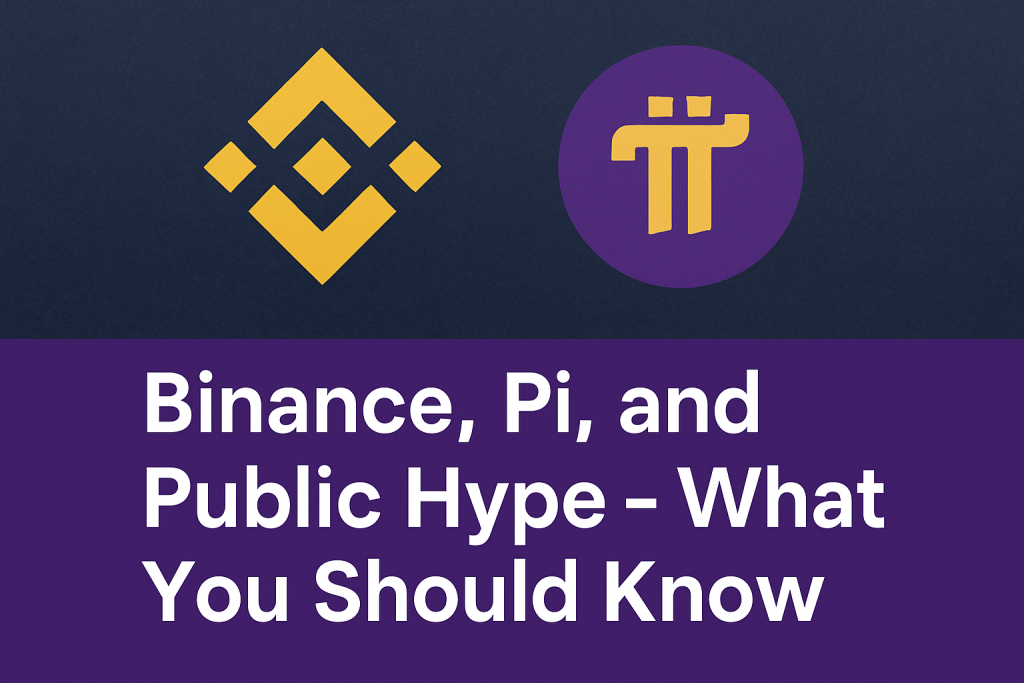The cryptocurrency space is no stranger to excitement, rumors, and speculation. In recent years, two names have dominated online discussions: Binance, the largest centralized exchange, and Pi Network, the mobile-mining phenomenon with millions of users worldwide. Together, they fuel conversations under a blazing headline: Binance, Pi, and Public Hype – What You Should Know.
Why does the public remain obsessed with Pi Network’s potential listing on Binance? What truths lie behind the growing speculation, and what do users need to understand to separate hype from reality?
This article takes a deep dive into the core of this narrative—analyzing technological developments, community expectations, exchange standards, and the psychology behind mass crypto movements. In exploring Binance, Pi, and Public Hype – What You Should Know, we clarify the facts, dismiss misinformation, and outline where things actually stand.
See more: Is Pi Network ready for Binance? Expert insights

What Is Pi Network?
To understand the hype, one must first grasp what Pi Network represents. Launched in 2019 by a team of Stanford graduates, Pi Network promised a vision where anyone could mine cryptocurrency directly from their smartphones. Without requiring advanced hardware or energy-heavy mining rigs, Pi took off quickly.
Key facts about Pi Network:
Built on the Stellar Consensus Protocol
Enclosed mainnet (as of 2025)
No open trading of Pi Coin
Focus on mobile adoption and community growth
Ongoing KYC (Know Your Customer) process
In-app tools like Pi Browser and Pi Wallet
The vast number of Pi users, combined with minimal real-time token utility, makes Pi Network both revolutionary and controversial. This blend feeds directly into the growing narrative of Binance, Pi, and Public Hype – What You Should Know.

What Is Binance?
On the other side of the discussion stands Binance. Founded in 2017, Binance rapidly became the most dominant crypto exchange in the world, known for:
High trading volumes
A wide variety of listed assets
Futures and spot markets
Staking, Launchpad, and DeFi integrations
Stringent listing requirements
Binance often serves as a benchmark for legitimacy in the crypto world. Being listed on Binance can signal to the global community that a project is secure, scalable, and recognized. No surprise, then, that Pi Network enthusiasts are constantly asking: When will Pi be listed on Binance?
But as we’ll explore throughout this article on Binance, Pi, and Public Hype – What You Should Know, things aren’t that simple.
The Source of Public Hype
Public excitement surrounding Binance and Pi is not accidental. Several factors contribute to this momentum:
1. Mobile Accessibility
Pi’s mobile-first model lowered the entry barrier, allowing millions—especially from emerging markets—to participate in crypto for the first time.
2. Enclosed Ecosystem
Because Pi Coin is not tradable yet, users anticipate that a listing on Binance would finally let them monetize or utilize their mined tokens.
3. Viral Marketing
Pi Network’s viral referral-based system encouraged exponential user growth, creating a sense of urgency and exclusivity.
4. Misleading Listings
There are fake Pi tokens on smaller exchanges, often misrepresenting themselves as the “real” Pi. Screenshots of these listings flood social media and mislead users into believing a Binance listing is imminent.
5. Influencer Endorsements
Crypto influencers frequently mention Pi, further inflating the hype, even when the project’s core features aren’t yet functional on a global, open blockchain.
All of these factors fuel the overarching conversation around Binance, Pi, and Public Hype – What You Should Know.

Technical Reality: Where Pi Network Stands Today
Despite massive public attention, the actual infrastructure behind Pi Network is still under development.
Enclosed Mainnet
The mainnet is enclosed, meaning Pi Coin cannot yet leave the ecosystem. Without open network functionality, no exchange—Binance included—can support deposits, withdrawals, or trading.
KYC Completion Delays
KYC rollout has not yet reached every user. Full compliance is essential before any listing on regulated exchanges like Binance.
Lack of Open Source
To date, Pi’s source code is not entirely public or externally audited. Transparency and open validation are standard requirements before Binance considers listing an asset.
Tokenomics and Regulation
Clear information on supply, distribution, and future emission schedules is lacking. Regulatory uncertainty also clouds the picture in various jurisdictions.
So when discussing Binance, Pi, and Public Hype – What You Should Know, we must acknowledge that Pi is not technically ready for Binance yet.
Binance’s Listing Requirements
Let’s explore what Binance actually demands from a project before listing:
| Requirement | Pi Network Status (as of 2025) |
|---|---|
| Open mainnet functionality | ❌ Not yet launched |
| Third-party audits | ❌ Still pending |
| Transparent whitepaper/tokenomics | ❌ Partial disclosure |
| Global KYC compliance | 🔄 In progress |
| Active external developer support | 🔄 Growing, but limited |
| Ecosystem utility | 🔄 In development |
| Regulatory alignment | 🔄 Jurisdiction-dependent |
| Community engagement | ✅ Extremely strong |
The chart reinforces that despite user growth, Pi lacks several components that Binance views as prerequisites.
Is the Hype Justified?
The short answer is: Partially.
Justified:
Pi’s massive user base gives it real market potential.
Innovative mobile mining model is attractive.
Ecosystem apps like Pi Browser show project momentum.
Not Justified:
No live trading or real-world utility yet
Confusing information about token legitimacy
Listings on shady exchanges without Pi Core Team approval
Social media campaigns spreading misinformation
Thus, Binance, Pi, and Public Hype – What You Should Know is a lesson in evaluating community-driven momentum against real infrastructure readiness.
Common Myths Debunked
Let’s address some myths tied to Binance, Pi, and Public Hype – What You Should Know:
Myth 1: “Pi is already listed on Binance”
False. As of this writing, there is no official Pi Coin listing on Binance. Any screenshots or “Binance test listings” are fabricated or misunderstood.
Myth 2: “Binance confirmed Pi is next”
False. Binance has made no official statement indicating Pi Network will be listed.
Myth 3: “You can trade Pi on PancakeSwap”
Misleading. Any Pi trading on platforms like PancakeSwap or other DEXs involves unofficial and unrelated tokens. These do not represent the Pi you mine via the mobile app.
What Experts Say
In examining Binance, Pi, and Public Hype – What You Should Know, we gathered expert insights from blockchain developers, regulatory analysts, and exchange insiders.
Developer View
“Pi’s architecture is novel, but it needs a transparent codebase and external validation before exchanges can consider it.”
– Senior blockchain engineer at Ethereum Foundation
Compliance Expert
“Without full KYC, especially in regions like the U.S. and EU, Pi cannot be listed on licensed exchanges like Binance.”
– Crypto regulatory attorney, London
Exchange Consultant
“User numbers matter, but liquidity, smart contracts, and infrastructure matter more. Pi isn’t there yet.”
– Exchange strategist with experience at KuCoin and Huobi
Roadmap to Listing
What must Pi do before it can hope for a Binance listing?
Open the Mainnet
Complete Global KYC
Release Transparent Tokenomics
Open-Source the Blockchain
Enable Wallet Integration with Exchanges
Obtain Regulatory Clarity
Submit Listing Application
These steps provide clarity in the broader conversation about Binance, Pi, and Public Hype – What You Should Know.
The Psychology of Hype
Why does hype persist despite delays?
Scarcity Effect
People believe Pi will explode in value once tradable, driving urgency.
Herd Mentality
If millions believe in Pi, new users feel inclined to join.
Economic Hope
In regions where financial inclusion is limited, Pi offers a perceived pathway to wealth.
Understanding these behavioral triggers helps decode Binance, Pi, and Public Hype – What You Should Know from a psychological lens.
Warning Signs and Scam Red Flags
If Pi is not listed on Binance yet, beware of:
Telegram groups offering Pi-USD swaps
YouTube videos claiming Pi-Token trades
Fake DEX tokens mimicking Pi
NFT projects “backed” by Pi without official sanction
Always verify through Pi Network’s official channels and Binance’s verified listings page.
Summary Table: Reality vs. Hype
| Topic | Hype Claims | Reality |
|---|---|---|
| Binance listing confirmed | ✅ Trending on social media | ❌ No confirmation |
| Pi token tradable | ✅ On minor DEXs | ❌ Unofficial, fake tokens |
| Ecosystem completed | ✅ Active apps | 🔄 Beta phase, limited utility |
| Regulatory compliance achieved | ✅ Claimed in forums | ❌ Not global |
| Price explosion imminent | ✅ Widely expected | ❌ No real trading yet |
This contrast is essential to understanding Binance, Pi, and Public Hype – What You Should Know in factual terms.
Final Thoughts
Binance, Pi, and Public Hype – What You Should Know is a narrative driven by innovation, optimism, and sometimes misinformation.
Pi Network represents a fresh, accessible approach to crypto, but it’s still building core infrastructure. Binance, as a leading exchange, maintains high standards to protect users and ensure compliance.
While a listing may happen in the future, the current hype must be tempered with reality. The best action for Pi users is to complete KYC, follow official updates, and avoid misleading claims from unverified sources.
In the end, staying informed is your strongest asset in navigating the noisy world of crypto speculation.

